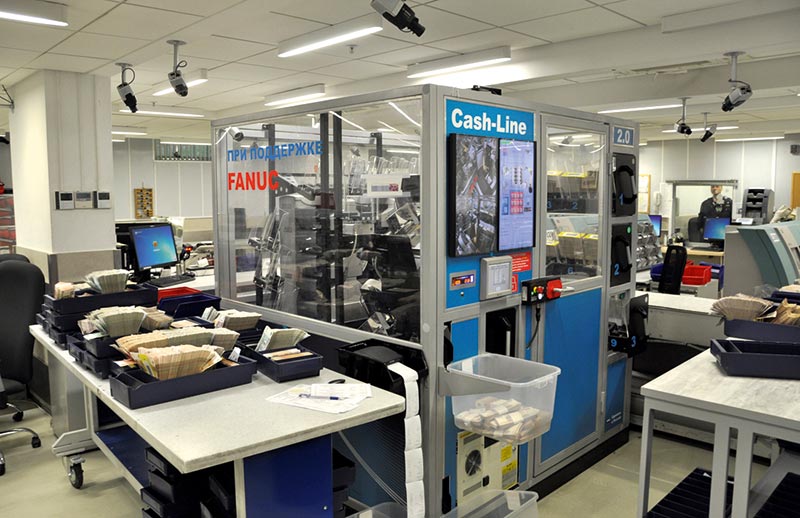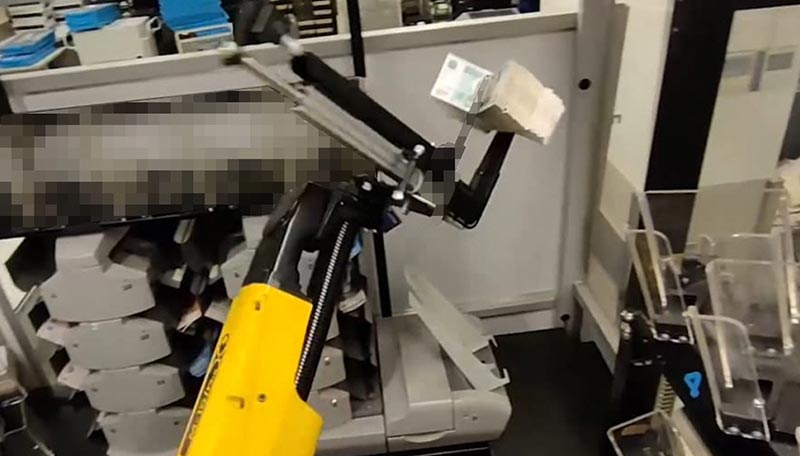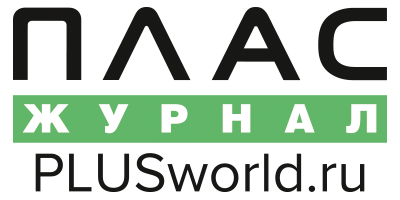VTB robotises
cash handling
VTB in partnership with DEEP 2000 offered the market a fundamentally new approach to cash handling.


Vladimir Ulikhin
DEEP 2000 CEO
DEEP 2000 CEO
Elena Chigirinskaya
VTB Vice President, Head of Cash Services at the Operational Business Support Department
VTB Vice President, Head of Cash Services at the Operational Business Support Department
Trends in the cash circulation development
The Guidelines for Cash Circulation Development for 2021−2025 announced by the Bank of Russia defined a number of tasks to be solved by market participants. The list of tasks includes improvement of business processes and relations between cash circulation stakeholders, enhancement of the industry infrastructure efficiency and reliability to be achieved, inter alia, through the introduction of modern technology in the cash handling segment — a very conservative one, as it might seem at first glance. Innovative solutions allow leading Russian banks to significantly optimise their business processes even today. Partnering with DEEP 2000, VTB became one of the leaders in cash circulation robotisation to offer the market a fundamentally new approach to cash handling.
The Guidelines for Cash Circulation Development for 2021−2025 announced by the Bank of Russia defined a number of tasks to be solved by market participants. The list of tasks includes improvement of business processes and relations between cash circulation stakeholders, enhancement of the industry infrastructure efficiency and reliability to be achieved, inter alia, through the introduction of modern technology in the cash handling segment — a very conservative one, as it might seem at first glance. Innovative solutions allow leading Russian banks to significantly optimise their business processes even today. Partnering with DEEP 2000, VTB became one of the leaders in cash circulation robotisation to offer the market a fundamentally new approach to cash handling.

A pivot towards robotisation: VTB’s disruptive case
Today, VTB is a Russian banking sector leader in terms of cash turnover. About 33 trillion roubles are processed within the cash circulation ecosystem perimeter.
In 2020, the bank launched a fully robotic cash processing line, a unique one not only by Russian, but also by global standards. The robotisation triggered fundamental rethinking of basic economic concepts such as labour productivity, length of investment payback period, output per employee.
The development of such an innovative approach was driven by the urgent need to improve productivity of processing of a significant amount of cash received by the bank, while reducing costs and minimizing operational risks.
This task required fundamentally new approaches and solutions. VTB’s operational business support staff did a big job to analyse the performance of various work sections responsible for standard operations associated with processing, sorting and packing cash in the cash centres. And the specialists concluded that it was possible to combine separate work sections into a single robotic line to increase significantly the efficiency of cash handling.
This is how the idea was born to use a robotic cash counting line (RCL) equipped with a robotic manipulator.
Today, VTB is a Russian banking sector leader in terms of cash turnover. About 33 trillion roubles are processed within the cash circulation ecosystem perimeter.
In 2020, the bank launched a fully robotic cash processing line, a unique one not only by Russian, but also by global standards. The robotisation triggered fundamental rethinking of basic economic concepts such as labour productivity, length of investment payback period, output per employee.
The development of such an innovative approach was driven by the urgent need to improve productivity of processing of a significant amount of cash received by the bank, while reducing costs and minimizing operational risks.
This task required fundamentally new approaches and solutions. VTB’s operational business support staff did a big job to analyse the performance of various work sections responsible for standard operations associated with processing, sorting and packing cash in the cash centres. And the specialists concluded that it was possible to combine separate work sections into a single robotic line to increase significantly the efficiency of cash handling.
This is how the idea was born to use a robotic cash counting line (RCL) equipped with a robotic manipulator.

DEEP 2000 is a leader in the market of cash processing technology solutions
To implement the new project, the VTB team approached DEEP 2000, a company, which is focused on utilising innovative technologies and believes that the future belongs to robotisation.
"We are demonstrating our capabilities energetically; our consultancy is sought-after by customers, including those from Europe and America. We encounter healthy conservatism in banks, and we notice that not everyone is ready to change the cash handling techniques and consider innovations in these processes. Our proposals will be of interest to those who have to process large amounts of money and consider the cash processing also as a business. Therefore, the VTB team’s project was of interest to us not only commercially-wise, but from a professional point of view as well. It was a definite challenge that we met," DEEP 2000 CEO Vladimir Ulikhin tells the PLUS Journal when speaking about the start of work on the project.
To complete the bank’s assignment, the DEEP 2000 team analysed the existing processes.
Every cash processing stage has been translated from 'the language of manual labour' to 'the language of robotics'. The major challenge and, at the same time, the key task was to make the new robotic system ensure 'direct copying' of all operations performed by the bank’s cashier.
To find a solution to this task, the DEEP 2000 specialists had to make an unparalleled technological feat.
To ensure the continuity of cash handling process that would reduce the high-tech counters and sorters downtime to zero, the frequency of a typical cashier’s operation should not exceed 5−6 seconds in 24/7/365 mode. Will the cashier cope with this problem? After all, apart from inserting banknotes into the sorter, cashier’s duties include other cash processing activities. Having identified the "trouble spot", the vendor suggested that cash centres should adopt the cash processing practices of the automotive industry, where robotic manipulators have long been used for monotonous and high-precision operations such as welding and painting, with the operations speed, accuracy and, most importantly, quality being under the utmost control. The robotic arm can perform complex operations with banknotes in a split second. It neither gets tired of monotonous routine operations, nor needs lunch, any rest or a sick leave, and at the same time it is not on the payroll.
At the first stage, the decision to improve production efficiency by using robots won a cautious welcome, but after the implementation and first successful tests, the robotic assistants became part of the VTB team.
Elena Chigirinskaya, VTB Vice President, Head of Cash Services at the Operational Business Support Department, says that all the classic phases of change management — from denial to acceptance — were passed through to attain that goal.
"Transformation of the psychology of people, overcoming their fears and worries was the first priority for us. VTB is committed to the social responsibility principles, so we have taken the path of retraining and retaining our personnel. After such reshaping, we were able to reinforce other key work sections with the retrained staff. After the automation of routine operations has been completed, the cash processing chain included employees, who had taken advanced training courses and migrated from manual labor directly to robotic process management," Elena Chigirinskaya points out.
To implement the new project, the VTB team approached DEEP 2000, a company, which is focused on utilising innovative technologies and believes that the future belongs to robotisation.
"We are demonstrating our capabilities energetically; our consultancy is sought-after by customers, including those from Europe and America. We encounter healthy conservatism in banks, and we notice that not everyone is ready to change the cash handling techniques and consider innovations in these processes. Our proposals will be of interest to those who have to process large amounts of money and consider the cash processing also as a business. Therefore, the VTB team’s project was of interest to us not only commercially-wise, but from a professional point of view as well. It was a definite challenge that we met," DEEP 2000 CEO Vladimir Ulikhin tells the PLUS Journal when speaking about the start of work on the project.
To complete the bank’s assignment, the DEEP 2000 team analysed the existing processes.
Every cash processing stage has been translated from 'the language of manual labour' to 'the language of robotics'. The major challenge and, at the same time, the key task was to make the new robotic system ensure 'direct copying' of all operations performed by the bank’s cashier.
To find a solution to this task, the DEEP 2000 specialists had to make an unparalleled technological feat.
To ensure the continuity of cash handling process that would reduce the high-tech counters and sorters downtime to zero, the frequency of a typical cashier’s operation should not exceed 5−6 seconds in 24/7/365 mode. Will the cashier cope with this problem? After all, apart from inserting banknotes into the sorter, cashier’s duties include other cash processing activities. Having identified the "trouble spot", the vendor suggested that cash centres should adopt the cash processing practices of the automotive industry, where robotic manipulators have long been used for monotonous and high-precision operations such as welding and painting, with the operations speed, accuracy and, most importantly, quality being under the utmost control. The robotic arm can perform complex operations with banknotes in a split second. It neither gets tired of monotonous routine operations, nor needs lunch, any rest or a sick leave, and at the same time it is not on the payroll.
At the first stage, the decision to improve production efficiency by using robots won a cautious welcome, but after the implementation and first successful tests, the robotic assistants became part of the VTB team.
Elena Chigirinskaya, VTB Vice President, Head of Cash Services at the Operational Business Support Department, says that all the classic phases of change management — from denial to acceptance — were passed through to attain that goal.
"Transformation of the psychology of people, overcoming their fears and worries was the first priority for us. VTB is committed to the social responsibility principles, so we have taken the path of retraining and retaining our personnel. After such reshaping, we were able to reinforce other key work sections with the retrained staff. After the automation of routine operations has been completed, the cash processing chain included employees, who had taken advanced training courses and migrated from manual labor directly to robotic process management," Elena Chigirinskaya points out.
Several years ago, first generation cell 1.0 was introduced. Now we have implemented second generation cell 2.0 for VTB, which is much different in terms of performance and ergonomics

Vladimir Ulikhin
DEEP 2000 CEO
DEEP 2000 CEO
Cash Counting Robot Project
The Proletarsky cash centre became the testing ground for the new cash handling technology. As part of the new project, two robotic sections for counting banknotes ("CashLine") were put into operation, based on Cummins Allison counting and sorting machines and Fanuc robotic manipulator.
The fundamentally new cash processing technology is a compact solution comprising a module with a 4 sq. m footprint. Capable of processing over 300 thousand notes per work shift, the solution validates and checks fitness of banknotes, sorting them by specified criteria (currency type, banknote denomination, worn-out state, etc.) and sending the banknotes requiring additional expert review into a rejection box.
The heart of the complex, the Fanuc robotic arm, quickly moves the sorted banknotes between the elements of the complex. The robotic arm is equipped with an innovative computer vision system, the latest security, control and monitoring technologies, which allows it to quickly identify faulty and abnormal situations (fallen banknotes, unacceptable items in the restricted areas of the complex, etc.) and generate a respective alarm message for the system operator.
To onlookers, the operation of the complex appears fascinating. It includes the following stages: first, the operator puts cash prepared for counting into special boxes, separated by identification cards bearing a barcode. All further stages of cash processing are carried out autonomously by the robot. It inserts the separated blocks of cash into the counting and sorting machine for counting, counts them, identifying worn, unfit and suspicious banknotes, forms and bundles banknotes of the same denomination. The complex operation results in the formed counterfoils of banknotes, ready for further use in the cash cycle.
Meanwhile, the robot assistants do not just perform a set of functions according to a given algorithm. The system software is integrated with the bank’s IT infrastructure, with all the counting totals being sent to the system automatically. This further accelerates the counting of cash received by the cash centre.
As Elena Chigirinskaya notes, the introduction of the RCL in the Proletarsky Cash Centre resulted in a significant economic benefit. The use of robots increased the productivity of the Proletarsky CC facilities by 20%, while the cash processing cost dropped by 51%. As a result, productivity gains allowed the counting volumes to be doubled. Today, the robot handles 400 out of 450 packs per shift processed in the cash centre. Other banknotes, which require separate sorting and examination, are counted by cashiers.
The implemented project and further technological re-equipment of the bank’s cash centres will allow a flexible system for the cash circulation cost management to be built in the bank. This, in turn, opens up new opportunities for the delivery of even better quality services to customers, which is a strategic development priority for VTB for the coming years.
The Proletarsky cash centre became the testing ground for the new cash handling technology. As part of the new project, two robotic sections for counting banknotes ("CashLine") were put into operation, based on Cummins Allison counting and sorting machines and Fanuc robotic manipulator.
The fundamentally new cash processing technology is a compact solution comprising a module with a 4 sq. m footprint. Capable of processing over 300 thousand notes per work shift, the solution validates and checks fitness of banknotes, sorting them by specified criteria (currency type, banknote denomination, worn-out state, etc.) and sending the banknotes requiring additional expert review into a rejection box.
The heart of the complex, the Fanuc robotic arm, quickly moves the sorted banknotes between the elements of the complex. The robotic arm is equipped with an innovative computer vision system, the latest security, control and monitoring technologies, which allows it to quickly identify faulty and abnormal situations (fallen banknotes, unacceptable items in the restricted areas of the complex, etc.) and generate a respective alarm message for the system operator.
To onlookers, the operation of the complex appears fascinating. It includes the following stages: first, the operator puts cash prepared for counting into special boxes, separated by identification cards bearing a barcode. All further stages of cash processing are carried out autonomously by the robot. It inserts the separated blocks of cash into the counting and sorting machine for counting, counts them, identifying worn, unfit and suspicious banknotes, forms and bundles banknotes of the same denomination. The complex operation results in the formed counterfoils of banknotes, ready for further use in the cash cycle.
Meanwhile, the robot assistants do not just perform a set of functions according to a given algorithm. The system software is integrated with the bank’s IT infrastructure, with all the counting totals being sent to the system automatically. This further accelerates the counting of cash received by the cash centre.
As Elena Chigirinskaya notes, the introduction of the RCL in the Proletarsky Cash Centre resulted in a significant economic benefit. The use of robots increased the productivity of the Proletarsky CC facilities by 20%, while the cash processing cost dropped by 51%. As a result, productivity gains allowed the counting volumes to be doubled. Today, the robot handles 400 out of 450 packs per shift processed in the cash centre. Other banknotes, which require separate sorting and examination, are counted by cashiers.
The implemented project and further technological re-equipment of the bank’s cash centres will allow a flexible system for the cash circulation cost management to be built in the bank. This, in turn, opens up new opportunities for the delivery of even better quality services to customers, which is a strategic development priority for VTB for the coming years.
Contacts
Photo credits: VTB Bank and DEEP 2000.
